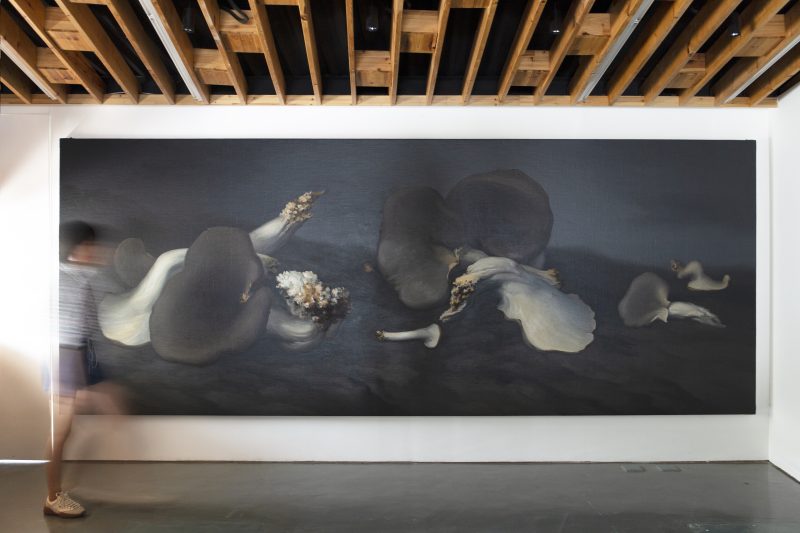
Opening Hours
Tuesday to Friday 10:00-18:00 (Last admission: 17:30)
Saturday and Sunday 10:00-19:00 (Last admission: 18:30)
Closed on Mondays
The Train Garden is open to the public every day
Tuesday to Friday 10:00-18:00 (Last admission: 17:30)
Saturday and Sunday 10:00-19:00 (Last admission: 18:30)
Closed on Mondays
The Train Garden is open to the public every day
111 Ruining Road, Xuhui District, Shanghai
021-33632872
info@startmuseum.com
A Pathway to the Root
Made of ready-made materials, Stove is from the earliest series of work by Yan Bing after his graduation. He found great comfort and support in the familiar scent of home during a homecoming trip. Therefore, like a swallow building mud nest, he uses materials such as earth and straw from his hometown to cover the vintage objects that represent memories, and recreates a dimly scene of life. Under this urban landscape, its unique rustic atmosphere is as gentle as within the mother’s body, providing a shelter for the soul. In Stove, the artist measures objects with his own body scale, making the work imbued with the sentiment of handcraft. The work prophetically suggests a connection to embodied experience in Yan Bing’s oeuvre, which opens a pathway for his following paintings depicting earth, seeds and fruits and their textures.
Compared to Stove, Earth and Mirror, while also made with earth, shows a tendency to be more flat and abstract. A thick piece of earth is spread on the mirror – the earth is trapezoidal in shape, like an obelisk, blocking the view of self-reflection in a decisive gesture. In terms of material and the treatment to it, we can find a commonality between this work and the mirror painting of Michelangelo Pistoletto, the pioneer of Arte Povera, both of them introduce the audience into the flatness through mirrors. However, Yan Bing attempts to create a space to dialogue with nature in order to interrogate the supremacy of man as the creator. Back to the earth itself, its abstract form, perhaps derived from the artist’s early painting practice of geometry, is the outline, the constituent of every faces, and is transformed into a figurative representation of indefinable and magnificent force here.
A Pathway to An End
The stocky form of the potato, its earthy colour and is rustic function to stuff oneself, make it an extremely important motif in Yan Bing’s work. In the early works, the potatoes are scattered on the table like still life. It is not until Half a Potato, in which the potato is cut half by a sharp knife, lying in the wilderness, that the motif gradually becomes sacred. The potato’s section is illuminated by an overhead light, like the light and dark sides of a face in a portrait painting. As a finale of the “potato” series, Half a Potato has been hanging in the artist’s studio. In a way, the work can be considered as a self-portrait of the artist, his upbringing as well as his thoughts all speak for itself in this image. In the continuous depiction of still life, Yan Bing has transcended the object itself, completing a monument of nature with a timeless and tranquil sentiment, showing a strong sense of the power of the origin.
A handful of mushrooms scattered on the black cloud-like earth, it shiny black cap providing a very dark vision against the texture of the glossy surface, showing a classical atmosphere. This ordinary creature is brought back to life like the soldiers in Rembrandt’s Night Watch. Scattered Mushrooms is the largest and final piece of Yan Bing’s “mushroom” series, for which he even destroyed a nearly completed work of the same size. These unobtrusive mushrooms are magnified to surreal proportions, as the solemn return of the ancient gods, gazing at the masses of life in an erratic time. In this work, the artist stirs up the boundaries of still life, landscape and even portraiture through stage-like forms and scenography, bringing endless dramatic tension to still life.
A Pathway to A Start
The tragedy and sublimity of violence has a fascinating appeal. One night after a gale raged, Yan Bing traveled along the track and found a mass of fallen trees like the corpses after a tragic battle, uttering the vagaries and fury of nature. As the opening of the “tree” series, Broken Tree shows a tree broken by a gale on the sand, its sharp wounds froze the momentum of the final blow. The tyranny of fate is just like this strong wind, mercilessly whipping the life, while only the silent persistence can fight it. In Yan Bing’s oeuvre, we can find the artist’s constant care and gaze on the ordinary living beings, making the will of life gradually emerge from the mediocre surface.